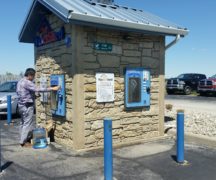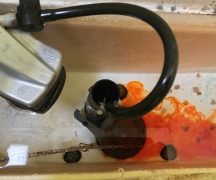By JAN LARSON McLAUGHLIN
BG Independent News
A roomful of residents – more curious than complaining – came together Tuesday evening to learn how water and sanitary sewer lines will change their lives and their pocketbooks.
The $11 million project will extend sanitary sewer and water lines to solve environmental issues and create economic development opportunities north of Bowling Green.
The project will affect 70 homes and businesses under order by the Ohio EPA to connect to public sewers, plus a potential 31 more properties in the area along the seven miles of sanitary sewer being installed.
The residents were civil, asking questions about the project damaging mature trees by their homes, crushing field tile and destroying crops, creating offensive odors, and requiring them to abandon their septic tanks.
Their questions were answered by officials with the Northwestern Water and Sewer District, the entity given the EPA orders to find a solution to pollution caused by leaking septic systems in the area.
The project calls for the extension of water and sewer lines east of Ohio 25, eastward along Ohio 582, continuing eastward to the small community of Dunbridge. From there, the sanitary sewer line will turn south on Dunbridge Road to the wastewater treatment plant in Bowling Green. The BG plant was found to be the most cost effective treatment, according to district officials.
The water line will stop at the railroad tracks in Dunbridge.
Residents along the route are required to connect to sanitary sewers that come within 400 feet of their homes. Connection to the waterline is voluntary. Gravity service or grinder pumps will be provided for each home in the affected area.
Garret Chamberlain, assistant engineer with the district, explained that the Ohio EPA sampled streams in the Dunbridge area in 2017 and again in 2022, and concluded that the old septic systems are dumping raw sewage into ditches.
The unincorporated community and its residents cannot afford to install a sanitary sewer, and many of the homeowners do not have adequate acreage or money to install new septic systems.
So last year, Northwestern Water and Sewer District officials made a pitch to the Wood County Commissioners for a share of the American Rescue Plan Act dollars to help with the project. The commissioners agreed to commit $9 million to the plan.
The Dunbridge community has numerous failed septic systems, according to Kelly Bechstein, a sanitarian with the Wood County Health Department. Most of the systems were installed in the 1970s or earlier. “They are discharging raw sewage,” Bechstein said during a meeting with the county commissioners last year.
Many of the residents are low income, and many have no space on their properties for new septic systems – so a sanitary sewer system is the best option, Bechstein said.
Though some of the residents may not be thrilled about the project and accompanying expense, David Dicke said he has encountered landowners who are much more hostile.
Dicke, who works on easements with American Property Analysts, told the crowd he has been shot at, “a guy tried to run me over with a combine,” and another sent a flock of turkeys after him.
In addition to providing needed sanitary sewers to Dunbridge, the project would also make the acreage on Route 582 near I-75 shovel ready with water and sewer services. The lines would be large enough to serve significant customers.
Developers have shown interest in access to 100,000 gallons to 2 million gallons a day.
So this would be a chance to solve an environmental problem and open up acreage for manufacturing and warehouse development, district officials said.
“There’s been interest for years out there,” District Executive Director Jerry Greiner said after the meeting with the commissioners. Water and sewer access could provide the missing piece.
Questions about the project can be directed to Amy Behrman, the project manager, at abehrman@nwwsd.org. Following are some details about the project presented Tuesday evening:
Estimated construction schedule
- Ohio EPA issued orders in March 2023.
- Final design in December 2023.
- EPA approval in January 2024.
- Property easement acquisitions from November 2023 to April 2024.
- Construction bidding in June-August 2024.
- Construction start in October 2024.
- Construction complete in December 2025.
Responsibilities of owners for household sewer connections:
- Connect to public sanitary sewer system within 120 days after project completion.
- Select a district licensed contractor to: Install lateral from home to sewer main or grinder pump; disconnect any stormwater, sump pumps and downspouts; and abandon septic tank per Wood County Health Department requirements.
The sewer main costs are being paid by the ARPA funding.
“Typically, there are debt charges or assessments,” Chamberlain said. But the ARPA funds from the county commissioners are paying for the project. So the estimated homeowner connection costs are:
- Connection to sewer estimated range: $3,000 to $5,000.
- District Inspection Fee: $275.
- Wood County Health Department Permit: $120.
- Well Meter (no district water service): Included.
- USDA 504 Program Grant & Loans: See district for details.
The billing is based on usage, and will have a one-time account set-up charge of $25. Monthly sewer only bill examples:
- For users of 3,000 gallons a month: $30.91 for district charge plus $20.05 for BG treatment charge, equalling $50.96 a month.
- For users of 4,500 gallons a month: $38.17 for district plus $30.08 for BG treatment, totaling $68.25.
- For users of 6,000 gallons a month: $45.35 for district, plus $40 for district, adding up to $85.35 a month.
The cost for voluntary water connection in the Dunbridge area will include:
- $2,850 for tap charge.
- $1,304 for system development fee (⅝-inch meter).
- $3,000 for unit charge.
- $1,000 well meter credit.
- Total of $6,154.
The homeowner will be responsible for the connection from the meter pit to the home. The expansion tank will be provided.
For those hooking up to water and sewer, the total monthly bill is estimated at:
- $95.14 for users of 3,000 gallons a month.
- $125.52 for users of 4,500 gallons a month.
- $155.57 for users of 6,000 gallons a month.





